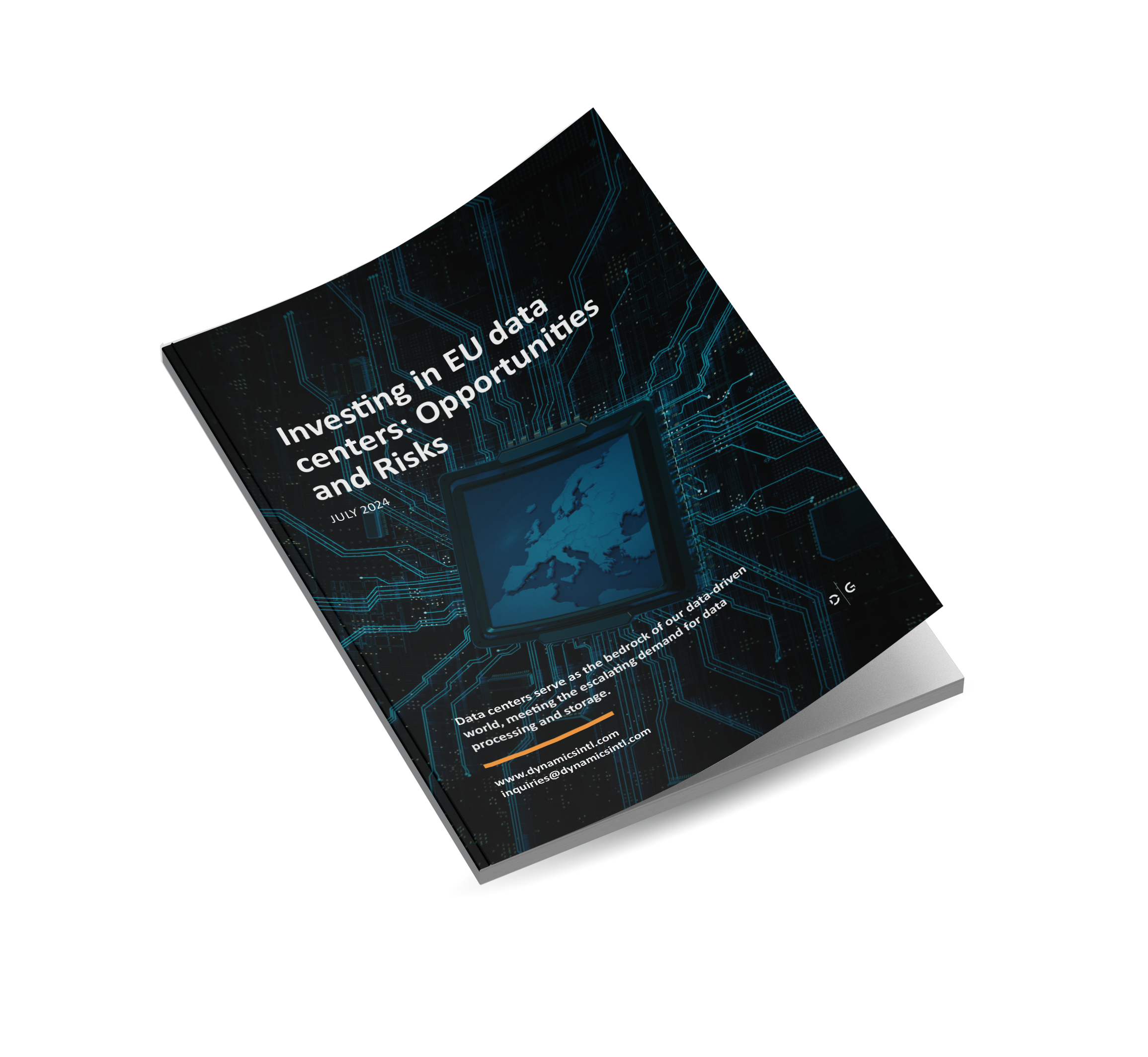Listen to the article – Investing in EU data centers: Opportunities and Risks
At-a-glance
- Data centers serve as the bedrock of our data-driven world, meeting the escalating demand for data processing and storage.
- EU data centers investing, like other niche property types, carries distinct opportunities, such as rising demand, favorable investment climate and financing.
- Power and cooling are by far the biggest risks, so geopolitical impact on energy and supply chain, competition, and skilled labor need to be considered in data centers investment risks.
- Data centers investment managers equipped with reliable actional intelligence will mitigate the risk more acceptable.
01
Tendency of data centers market in Europe
01
Tendency of data centers market in Europe
Today, we are living in the technological revolution era. AI is rapidly changing our lives and the global market. Even though AI has been used by many enterprises in the form of data analytics and machine learning for years, the rise of Generative AI is enhancing the sector into a new stadium.
As AI adoption increases, so does the need for data storage and processing capabilities. This surge is driven by AI’s need for substantial computational power, making data centers pivotal in supporting AI operations. We’re witnessing a new era of data center utilization, driven by advancements in application optimization, processing power, and design. Google serves as an excellent example: In media processing, they’ve transitioned from five older servers running YouTube to a single, highly optimized server equipped with low-power ASICs. This shift underscores the industry’s focus on efficiency and innovation.
As Europe is trying to keep its competitive pace with USA and China the convergence of AI and data centers operations is transforming Europe’s digital infrastructure landscape. Europe has shown a remarkable rise in activity.[1] According to the statistics the European AI market will rise by 25.9% compared to 2023 and reach €76.5 billion this year, with projection for an annual growth rate of 15.9% until 2030. On the other side, the data center’s construction cost is also projected to increase by 6.5% annually to €8.4 million per megawatt. This trend highlights Europe’s expanding importance in the data centers market.
Consequently, by monitoring the trends in the AI and data centers industry, the report tries to uncover Europe’s data centers investment opportunities and risk in support of the strategic planning and decision-making process.
02
Opportunities
02
Opportunities
Clearly, the EU data center market is undersupplied and investment in data centers exhibits opportunities such as: rising demand, favorable investment climate and financing.
- Rising demand
Aforesaid, AI extensively influences the demand for data center facilities. Primarily, AI applications, especially those employing deep learning and complex algorithms, demand extensive computational resources. As a result, there’s a growing need for cutting-edge data centers equipped with robust hardware to handle increased workloads effectively.[2] Currently, these data centers are projected to increase in scale, accommodating sizable server farms and enhanced storage capacities. Additionally, specialized hardware like GPUs and TPUs need to be adopted to meet AI model training and inference demands.
This trend toward sophisticated facilities will drive advancements in cooling and power distribution systems, albeit with increased power consumption. While many hyperscale AI data centers are location-agnostic, they’ll likely concentrate in regions with abundant green energy. Simultaneously, edge data centers near data generation points will gain importance to minimize latency, leading to a more decentralized network of facilities supporting AI capacities.
In short, the demand for data centers in Europe has surged due to the widespread use of the internet. As it becomes an integral part of everyday life, enterprises are adopting cloud services. Additionally, the emergence of AI as a new trend is creating substantial requirements for expanded data center capacity.
- Investment climate
Despite growing interest from an investment perspective, Europe’s data center investment market is still in its developing stages, offering plentiful opportunities for investors. Direct acquisitions or development investments in data center assets leased to hyperscale companies yield high and stable rental income over the long term. The same holds true for share-based investments.
Moreover, in this relatively scarce European market, data centers’ high productivity and the competition for properties with ample energy supply in strategic locations are driving rent increases.
Download Report
Investing in EU data centers: Opportunities and Risks
Data centers serve as the bedrock of our data-driven world, meeting the escalating demand for data processing and storage.
The prevalence of preleasing new facilities underscores the ongoing investment demand in data center development. Still, purchase prices are rising even faster, resulting in yield compression over time. Seizing these opportunities now allows investors to benefit from yield compression, especially given the current low but rising interest rates for financing such transactions.
Simultaneously, the EU authorities are adopting Directives advancing the states to create sustainable conditions that will have long term effects on data centers investments. Alongside the EU’s Digital Strategy, the recast Energy Efficiency Directive (EU) 2023/1791,[3] aims to reduce energy consumption by 11.7% by 2030, and data centers energy performance will be monitored. This will ultimately enhance transparency and draw more investors to the sector.
In the end, EU investment climate is becoming more and more favorable for investments in AI and data centers. To support the growing in the sector, access to capital is another opportunity for investors.
- Financing
Financing the EU data center market presents a long-term opportunity. Apparently, specific themes and issues significantly influence sponsor and lender considerations in each case. But Even financing is considered as short-term risk, data center owners employ corporate structuring to segregate completed or ‘stabilized’ data center assets into distinct corporate entities. This strategy shields investors from certain risks associated with data center development, making it more appealing for funds and financial sponsors who might otherwise be hesitant to enter the digital infrastructure market.[4] Additionally, as data centers achieve income stability, transitioning to Asset-Backed Securities (ABS) provides a cost-effective method to refinance existing bank debt. As data center transactions mature, expectations point to increased activity in the European Asset-Backed Securities (ABS) sector. Recently, Europe witnessed its inaugural ABS issuance in the data center industry, totaling €713.4million. As owners seek to optimize financing and unlock capital, the sector appears poised for further ABS adoption, indicating the emergence of a market with large potential.
In summary, financing often entails complicated bespoke corporate and financing structures. The investment sector is becoming more regulated, and complex development and offtake contracts significantly impact value. Nevertheless, the rising demand for data centers creates opportunities for financing the sector to be more reachable and doable. What about the risks?
03
Risks
03
Risks
The opportunities come with inherent risks. Imposing risks from geopolitical trends and events of power and cooling constraints, regulatory compliance, increasing market competition, skill labor shortages, underlines a strategic approach to investment.
- Geopolitics
The Russian war in Ukraine, and energy supply chain disruption underscores the critical importance of Europe’s geopolitical and country risks for data centers. Additionally, geopolitics influence rising construction material prices and stringent energy efficiency requirements and add more pressure. Plus, extreme weather events further threaten supply chain operations and EU’s data center locations should be evaluating the risk profile within a company’s risk tolerance, since the operations depend on water and energy. Therefore, ensuring a stable and sufficient power supply, especially in major metropolitan areas, can be difficult and expensive. Failure to secure adequate resources can limit data centers capacity and scalability. These facilities, crucial for AI training, rely on water for cooling computer systems, consuming up to 5 million gallons per day.[5] Thus, natural resources become a zero-sum game, especially when competing powers refuse to negotiate or compromise. Even without direct competition, resource acquisition can pose risks, leading countries to grapple with limitations when resources are scarce.
Moreover, EU’s evolving regulatory landscape regarding sustainability and data protection, which is adjusting on geopolitical dynamics and Ukraine war, can impose additional operational costs and complexities, making compliance a critical factor for investors. Non-compliance can result in hefty fines and damage to reputation, making it crucial for investors to stay abreast of regulatory changes and integrate compliance into their strategies.
All in all, geopolitical, country risk and regulatory factors take precedence, as they significantly impact operational stability. Recent geopolitical trends and events serve as a cautionary tale, emphasizing the need for thorough risk assessment to inform strategic decisions.
- Competition
As the demand for data centers grows, so does the competition. The European data center market is characterized by dynamic competition among global and local operators and presents a risk if not assessed accordingly. Hence, data center companies are competing fiercely for market share in the region, with ongoing investment, supply challenges, and a focus on meeting power demands and AI-related requirements. Both established players and new entrants are vying for market share, which can drive down prices and squeeze profit margins. So strategic differentiation and value-added services are critical in maintaining a competitive position. Since there is a rising demand for investment the competition for getting the best location led to fewer vacancies and increased rental growth rate.[6]
Also, emerging markets as Africa, Latin America, the Middle East, India, Thailand, and Vietnam are also competitors as there is an increased data center development.[7] In that sense, for data center investors and developers seeking higher returns, these nations appear attractive despite the heightened risks compared to more developed markets. On the other side, data sovereignty initiatives will influence data storage locations and drive demand for new centers.
Lastly, while investing in EU data center involves competition risk from already established players, creating feasible strategic investment strategy contributes to stable cash flows, making the investments compelling.
- Skilled labor
Succeeding the demand curve, data center operators face skill labor demand challenges, particularly in a rapidly evolving industry. So, a significant shortage of skilled personnel is prevalent, mirroring challenges faced by the broader technology sector. Research reveals that 53% of operators encounter difficulties in recruiting qualified staff, and 42% have lost employees to competitors.[8] Meaning that, this situation not only intensifies pressure on existing teams but also jeopardizes operational quality and safety. Therefore, retaining talent becomes crucial to ensure successful project delivery. That said, recruiting and retaining talent capable of managing advanced AI-driven data centers is hindering operational efficiency and growth.
Even though EU Code of Conduct for Data Centers[9] promotes skill development, the rising demand cannot fulfill the skill labor needed. One of the most significant challenges in recruiting for data centers is the industry’s relative invisibility and the limited awareness of diverse career opportunities beyond programming or data processing roles. In that sense, the rise of technologies, including AI applications, might exacerbate the labor shortage by rapidly altering the demand for specific specialized skillsets. This suggests that the skills needed previously may differ from those needed now.
In short, efforts are underway to attract individuals to positions in operations, business development, engineering, project management, and IT. While progress has been made, investors should assess and plan the labor needs prior to making decisions.
04
Bringing up rear
04
Bringing up rear
Understanding these trends and their implications is crucial for investors looking to capitalize on the future of European data centers.
As businesses, consumers, and emerging technologies rely more on data, data centers have become the bedrock of our data-driven world. Data centers offer appealing investment opportunities due to strong supply/demand dynamics, entry barriers, and defensive valuation attributes. However, the industry’s relative newness and technical complexities can deter some investors. We outline key opportunities and risks that investors should need to assess before making decisions. By mitigating these risks and seizing opportunities, industry leaders can shape a successful future for EU data centers.

ARTICLE | 17 PAGES




